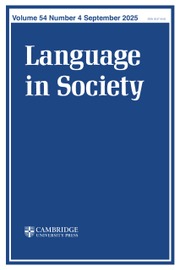Article contents
Stance-taking and participation framework in museum commenting platforms: On subjects, objects, authors, and principals
Published online by Cambridge University Press: 22 February 2019
Abstract
The realization of subjectivity through language use is a key concern of sociolinguistic research. We argue for examining it by juxtaposing Goffman's participation framework and Du Bois’ stance triangle. We focus on museums’ commenting platforms as ‘stance-rich’ media (Du Bois 2007:151) by examining the communicative affordances of a visitor book at the Florida Holocaust Museum and analyzing museumgoers’ texts (3,064). These texts are homogeneous in their morally indignant evaluation of the Holocaust and their alignment with the museum, but heterogeneous in positioning and participation framework. Museumgoers’ texts are highly responsive to the setting and previous discourses of the museum and include patterns of shared authorship and principalship. These patterns allow museumgoers to construct shared, institutionally mandated, subjectivities while maintaining personal commitment. These findings contribute to our understanding of the construction of subjectivity as inherently dialogic, and as involving the purposeful use of a multiplicity of contextual resources. (Participation framework, stance triangle, repetitions, principalship, commitment, Holocaust, museums, visitor books)
Information
- Type
- Articles
- Information
- Copyright
- Copyright © Cambridge University Press 2019
References
REFERENCES
- 8
- Cited by

